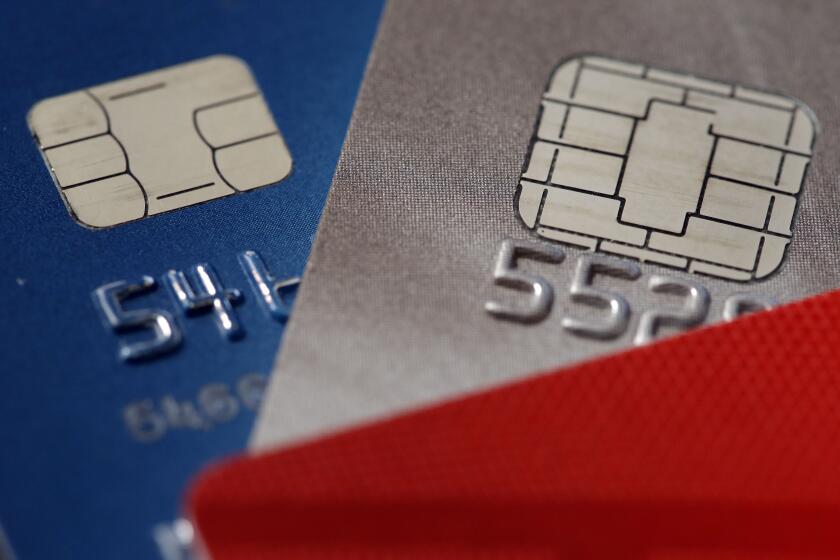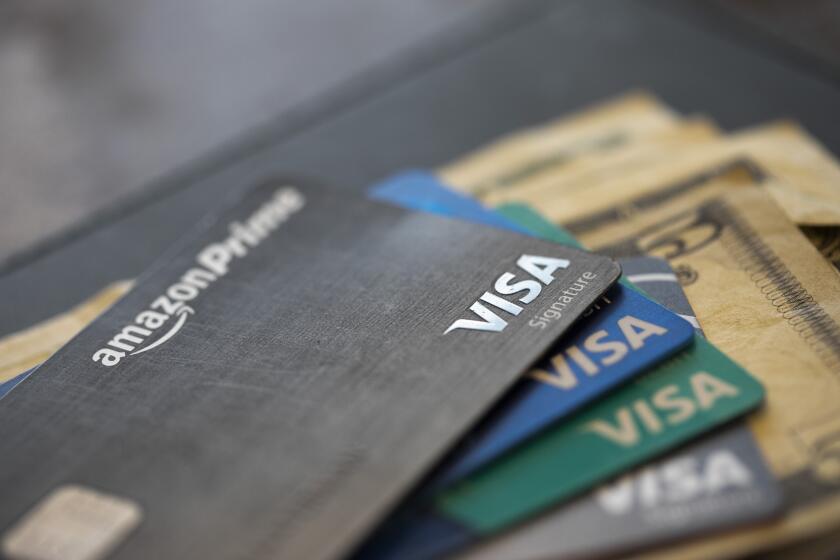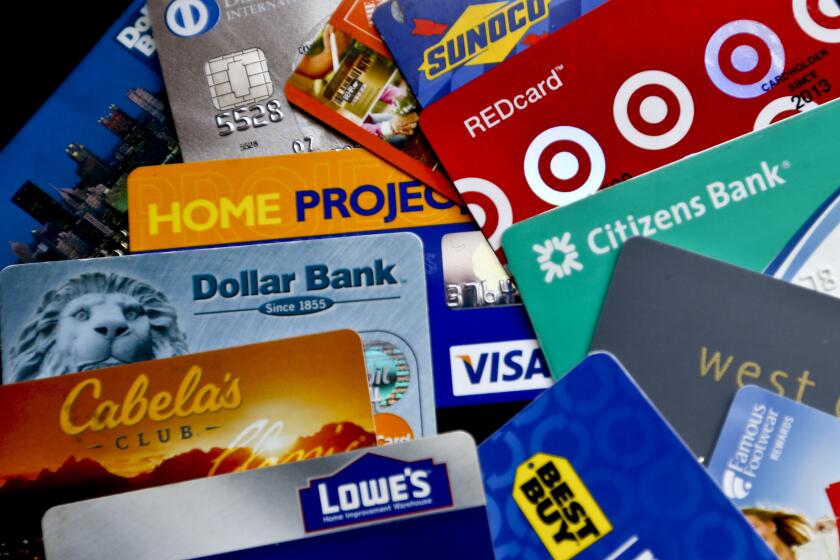Credit card debt is at record high as Fed raises rates again

- Share via
As the Federal Reserve raises interest rates again, credit card debt is already at a record high, and more people are carrying debt month to month.
The Fed’s interest rate increases are meant to fight inflation, but they’ve also led to higher annual percentage rates for people with credit card debt, which means they pay more in interest. The Fed announced Wednesday that it would increase rates another quarter of a percentage point.
With inflation still high, people are leaning on their credit cards more for everyday purchases.
“It’s the economy, inflation, gas prices, and food costs,” said Lance DeJesus, 46, kitchen manager at the Golden Corral in York, Pa. “A year ago, you could go to the grocery store with a hundred bucks and come out with a bunch of bags. Now, I come out with just one bag.”
DeJesus said he carries a credit card balance of roughly $2,600 from month to month over several cards, which have interest rates from 16.99% to 21.99%.
A big credit score drop may indicate a late payment, collection account or fraud. How to check your credit reports at all three credit bureaus.
Early in the pandemic, when DeJesus lost his job, he said that unemployment payments, stimulus checks and child tax credits (which went to his household via his wife, who has three children) all helped him stay afloat. Now, with COVID-era emergency relief and stimulus policies ending, he uses credit for emergencies.
He’s not alone: 46% of people are carrying debt from month to month, up from 39% a year ago, according to Bankrate.com, an online financial information site.
Bankrate says the average credit card interest rate, or annual percentage rate, has reached 20.4% — the highest since its tracking began in the mid-1980s.
In a new poll by the Associated Press-NORC Center for Public Affairs Research, 35% of U.S. adults report that their household debt is higher than it was a year ago. Just 17% say it has decreased.
Roughly 4 in 10 adults in households making less than $100,000 a year say their debt is up, compared with about a quarter in households making more than that. About half of Black and Latino adults say their household debt has increased, compared with about 3 in 10 white adults.
With conditions changing by the hour, traditional economic data points — typically released monthly or quarterly with a lag — prove less helpful. Here are some better ways to gauge economic health.
Data also show that more people are now falling behind on payments, said Bankrate analyst Greg McBride. He sees this as evidence of a so-called “K-shaped recovery” from the pandemic, in which the distance between the haves and the have-nots grows larger.
“The more than half who pay in full each month are clearly doing a lot better than the almost half who don’t,” McBride said. “Those who tend to carry balances tend to be younger people, people making lower incomes and those with lower credit scores. Another factor contributing to rising debt is inflation, which means the cost of day-to-day living is outpacing paychecks.”
Typically, on a national scale, it takes something pretty extraordinary for credit card balances to fall, economists agree. The Great Recession, beginning in 2008, and the COVID-19 pandemic, beginning in 2020, are two periods when they fell sharply.
During the early part of the pandemic, credit card debt fell 17%, Bankrate said, thanks in part to stimulus programs, emergency relief and a decrease in consumer spending.
But in the last three months of 2022, credit card balances in the U.S. increased $61 billion to $986 billion, surpassing the pre-pandemic high of $927 billion, according to the Federal Reserve Bank of New York.
Credit bureaus pay attention to your credit utilization, or how much of your combined credit card limits you’re using. Here’s how to manage it.
Using a credit card can provide protections for people who can pay off the balance every month. But the cost for those who can’t is high.
“What’s not good is carrying balances, paying interest, and falling behind,” McBride said. “No one wants to be paying 20% every month.”
For Gary Deuvall, 68, of Walls, Miss., who worked servicing and repairing motorcycles, stimulus checks brought some financial relief even though the pandemic hurt his business.
Now retired and on Social Security, Deuvall and his wife still have some credit card debt, he said, “in the five figures,” but they’ve also transferred that balance to a no-interest card to help contend with high rates.
No-interest offers are generally available for only a limited period, sometimes up to 21 months, and banks sometimes charge a flat fee, such as 3% of the balance transferred.
“We’d hoped to build or buy a house,” Deuvall said. “But interest rates are so high, that’s on pause. Meanwhile, I’ll just rent.”
Dan Stokes, 31, a special education teacher based in Richmond, Va., said that a pause on student loan payments that began during the pandemic has helped him make ends meet, but he still carries about $8,000 in credit card debt from month to month across at least three cards.
Of that, Stokes said he’s moved about $1,200 to a no-interest card for the next 12 months.
“Honestly, it feels really good that I don’t have to make those student debt payments at the moment,” he said of the emergency policy, which has been extended until the summer. “My pay as a teacher hasn’t kept up with inflation, so there are times when I’m swiping my credit cards just to get by and make it through.”
Credit card rates are one of the fastest ways higher interest rates hit consumers.
“Most car loans and mortgages are fixed-rate. So if you’re new to the market, it has a big effect, but if you have an existing loan, it’s not affecting you,” McBride said. “With credit cards, the higher interest rate gets passed through pretty much right away.”
The poll of 1,081 adults was conducted March 16-20 using a sample drawn from NORC’s probability-based AmeriSpeak Panel, which is designed to be representative of the U.S. population. The margin of sampling error for all respondents is plus or minus 4 percentage points.
AP polling editor Emily Swanson in Washington contributed to this report.
More to Read
Inside the business of entertainment
The Wide Shot brings you news, analysis and insights on everything from streaming wars to production — and what it all means for the future.
You may occasionally receive promotional content from the Los Angeles Times.













